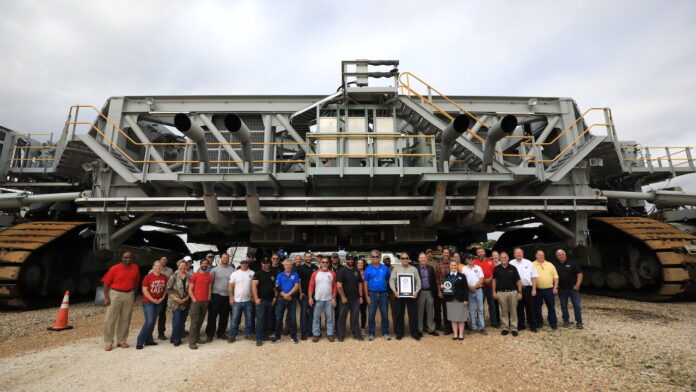When NASA’s Crawler Transporter 2 carries the Artemis Moon rocket to its launch pad, the behemoth machine will be sporting a Guinness World Records certificate officially designating it as “the heaviest self-powered vehicle.”
Approximately 6.65 million pounds, the crawler—one of two constructed in 1965—weighs about as much as 15 Statues of Liberty or 1,000 pickup trucks, earning it the record title for heaviest self-powered vehicle(Opens in a new window).
During a recent ceremony at NASA’s Kennedy Space Center in Florida, Guinness World Records adjudicator Hannah Ortman presented an official certificate to teams with the Exploration Ground Systems Program and Kennedy leadership.
“Anyone with an interest in machinery can appreciate the engineering marvel that is the crawler transporter,” Exploration Ground Systems Program Manager Shawn Quinn said in a statement(Opens in a new window). “This crawler captured the attention of the world during the Artemis I mission when it carried the rocket and spacecraft that will send our astronauts to the Moon to the launch pad.”
Originally designed to carry Saturn V rockets during the Apollo program, which ran from 1961 to 1972, the second crawler has undergone some upgrades, allowing it to carry the heftier load of newer-generation rockets. The improvements—including replacing two locomotive engines and strengthening other systems—added more bulk, ultimately making Transporter 2 heavier than its non-record-breaking sibling.
Recommended by Our Editors
“NASA’s crawlers were incredible pieces of machinery when they were designed and built in the 1960s,” says John Giles, NASA’s Crawler Element Operations manager. “And to think of the work they’ve accomplished for Apollo and shuttle and now Artemis throughout the last six decades makes them even more incredible. To have a Guinness World Records title is icing on the cake for an extraordinary piece of equipment.”
Thanks to all that extra tonnage, the 4.2-mile trek from the Vehicle Assembly Building to the launch pad could take the 131-foot-long, 114-foot-wide vehicle anywhere from eight to 12 hours.
Get Our Best Stories!
Sign up for What’s New Now to get our top stories delivered to your inbox every morning.
This newsletter may contain advertising, deals, or affiliate links. Subscribing to a newsletter indicates your consent to our Terms of Use and Privacy Policy. You may unsubscribe from the newsletters at any time.
Hits: 0
















